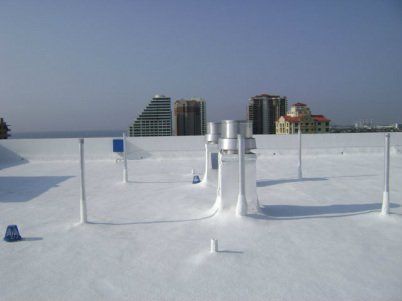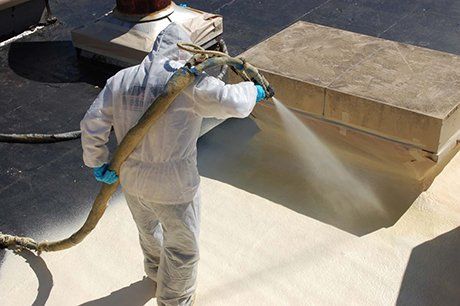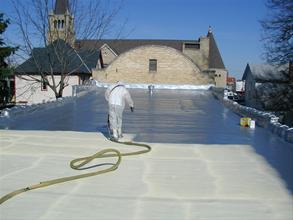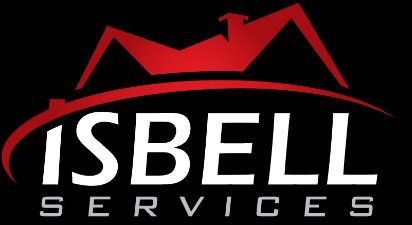CALL US FOR ALL YOUR HOME REMODELING NEEDS // (205) 769-4438
SPRAY FOAM ROOFING



What is Spray Foam Roofing?
Our Commercial Roofers Provide Spray Foam Surfaces in the Tuscaloosa, AL Region
Spray Polyurethane Foam
has been used as a roofing and insulation material for over 45 years. During this time, foam roofing systems have proven themselves through comprehensive, independent studies to be dependable, long lasting, and very affordable. Today there are foam roofs that have been in place for decades, and by all appearances they should be able to last indefinitely as long as they are properly maintained.
Sprayed Polyurethane Foam is a combination of isocyanate and polyol. These two components are fed through a proportioner which heats then pumps the two separate components to the spray gun, where they are mixed and sprayed onto the substrate. Because it is sprayed onto the roof as a liquid, it forms a single continuous structure that is seamless and very stable. SPF requires a clean surface for proper application. It must be dry, free of contaminants like oil, and properly fastened to the substrate in accordance with the proper building codes. A protective elastomeric top coat is required which is typically sprayed on as well, but it is also possible to be applied with hand or power rollers.
Since its development, spray foam roofing has been shown to have many advantages
over traditional commercial roof techniques and methods. From its high durability and watertight seal to its insulation and energy-efficient design, this eco-friendly roofing choice is perfect for commercial, industrial, and manufacturing facilities. At Isbell Services, our roofing company takes pride in offering this service and product to commercial businesses across the Tuscaloosa, AL area.
Here are some brief examples:
Seamless
Polyurethane foam is applied as a liquid, creating a single monolithic membrane that covers the entire roof. There are no seams or joints, the source of the majority of leaks in traditional roofs.
Flexible: The foam can be sprayed onto virtually any surface, irregularly shaped roofs and protrusions are readily taken care of.
Lightweight: Foam roofing typically weighs around 50 lbs. per square, versus 800 lbs. for a built-up roof and 100 lbs. for ballasted single-ply roofs.
Thermal Insulation: SPF has the best insulating properties available for commercial construction today.
Sustainability: Foamed roofs require a minimum of upkeep, creating little waste and have an indefinite lifespan.
Insulation Properties of SPF systems
Sprayed polyurethane foam has an R-value of 7.14 per 1 inch thickness, enabling it to provide more thermal resistance with less material than any other type of roofing insulation.
Foam roofing produces energy savings of 30% or greater when compared to the alternative roofing systems. The cost of the roof can be easily recovered in under 5 years, simply through these energy savings alone!
Insulating Freezers, Tanks and Other Structures
SPF systems are frequently used to insulate and protect a wide variety of special structures. It has been used with great success in the oil industry, chemical process plants, even in the wine industry.
SPF's Waterproofing Ability
Sprayed Polyurethane Foam is perfect for many different waterproofing applications. Because it is composed of billions of closed cells, the foam acts as an air barrier, preventing moisture infiltration into the building. This ability minimizes dew point problems, which unchecked leads to water condensation inside of the structure. Moisture infiltration into the building envelope is the number one cause of building deterioration.
Even when the top coat of a foam roofing system is damaged, the underlying foam will keep the roof from leaking. The Superdome in New Orleans was damaged once in a severe hail storm. Thousands of hairline cracks appeared in the top coat, but no leaks ever occurred, even though it wasn't repaired for over a decade!
If a penetration does occur all the way through the foam layers, the water infiltration will be isolated only to the area where the membrane has been penetrated. Small penetrations in foam roofing systems can be repaired easily with an elastomeric caulk, reinstating the integrity of the system.
Water ponding is quite often a problem with conventional roofing systems. When applying the polyurethane foam in reroofing situations, it is very easy to build up areas of greater thickness while spraying. so that water will drain properly. This also eliminates the problem of the additional weight load associated with water accumulation.
Elastomeric Coatings
Sprayed Polyurethane Foam has to be protected from exposure to the sun's ultra-violet radiation and moisture. This is where the top coating comes in, it helps to protect and seal the foam from any damage. There are several basic requirements for a coating to be effective, which we will outline below.
Elastomeric
A polyurethane foam roof will expand and contract during the course of a day, do to temperature changes on the upper surface of the foam. The coating must be able to stretch with the foam, and return to its normal shape later. The stretching of the coating is technically called elongation. If a rigid coating is applied to a foam's surface, serious damage can result. As the foam flexes and moves, the coating will crack or rupture, exposing it to the climate. The minimum amount that a coating should be able to elongate is 100%.
Strength: The coating must be tough enough to withstand the local climatic conditions and any traffic on it. The tensile strength is very important. The coating must be able to resist the deformation caused when a load or force is applied to it. This strength is measured in pounds per square inch (psi).
Insulation Protection
The insulating properties of the foam can be compromised by moisture vapor. The coating needs to be able to protect the foam from a build up of this vapor, so that it won't reach the dew point. How water permeable a coating needs to be is based off of the temperatures and humidity differences that the roof is exposed to. The Moisture Vapor Transmission is a measure of the rate of movement of moisture vapor in unit time through a unit area of a membrane. Ratings are expressed in 'perms,' and classified in two major categories, vapor 'retarders' and 'breathers.' A vapor 'Retarder' is a coating that has a perm of 1 or less, moisture is highly impeded by it. A 'breather' coating allows the passage of a greater amount of moisture vapor.
Fire Safety Requirements
The combination of the foam and the coating has to pass the applicable code requirements for exterior and interior fire exposure. The system should be rated Class A by ASTM E-108 or an equivalent testing method.
Schedule an Appointment With Our Commercial Roofing Specialists
With a wide variety of advantages to spray foam roofing, it’s important to assess your roofing needs to ensure you’re making the right decision. As a local, family-owned roofing company, Isbell Services is proud to help keep your business, guests, and employees protected, all while having your best interests in mind.
In addition to our spray foam roofing service, we also offer complete roof repairs to provide your company with peace of mind for the long term. If you are interested in spray foam roofing, insulation, or commercial roof repairs, please feel free to contact our team to schedule an appointment!
Write a Review!
ISBELL SERVICES
Your Local Home Remodeling Company in Tuscaloosa, AL
Isbell Services | 2519 28th St., Tuscaloosa, AL 35401 | 205-769-4438
Web Design
by LocalEdge, all rights reserved
